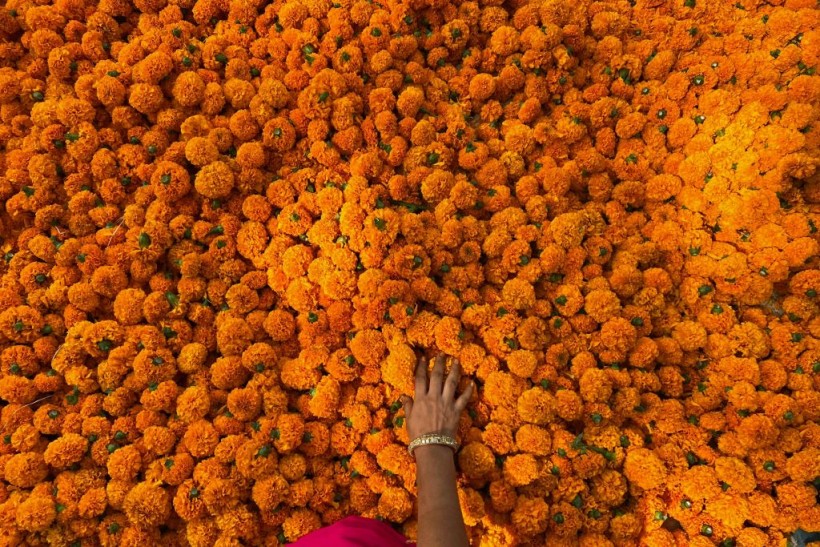Flowers are not only beautiful and fragrant, but also powerful allies for farmers and bees.
In India, where agriculture is the main source of livelihood for more than half of the population, some farmers are planting flowers around their fields to attract and support pollinators, especially bees, which are essential for many crops.
This not only improves their crop yields and quality, but also provides them with an additional source of income from honey and other bee products.
How farmers are turning to flowers to save their crops and income
 (Photo : INDRANIL MUKHERJEE/AFP via Getty Images)
(Photo : INDRANIL MUKHERJEE/AFP via Getty Images)

In India, where agriculture is the main source of livelihood for more than half of the population, farmers are facing a double challenge: declining crop yields and dwindling incomes.
One of the reasons for this is the loss of pollinators, especially bees, which are essential for many crops, such as fruits, vegetables, nuts and spices.
According to a study by the Indian Council of Agricultural Research, India has lost about 50% of its honey bee colonies in the past three decades due to various factors such as habitat loss, pesticide use, climate change and diseases.
This has resulted in reduced crop quality and quantity, affecting the food security and income of millions of farmers.
To address this problem, some farmers are turning to flowers as a solution. By planting a variety of flowers around their fields, they are creating habitats for bees and other pollinators, enhancing their crop pollination and increasing their honey production.
This not only improves their crop yields and quality, but also provides them with an additional source of income from honey and other bee products.
Also Read: Flower Recycling: What Are the Benefits to the Environment?
How flowers benefit bees and farmers
Planting flowers around farm fields has multiple benefits for both bees and farmers. For bees, flowers provide a rich and diverse source of pollen and nectar, which are essential for their nutrition and health.
Flowers also attract other beneficial insects, such as butterflies, moths, beetles and flies, which can also pollinate crops and control pests.
For farmers, flowers can improve their soil quality, prevent erosion, conserve water, reduce weed growth and enhance the aesthetic value of their farms.
They can also serve as a buffer zone between crops and nearby roads, factories or other sources of pollution, protecting their crops from contamination.
Moreover, flowers can boost the farmers' income by providing them with honey and other bee products, such as wax, propolis and royal jelly.
Honey is a valuable commodity in India, where the demand exceeds the supply. According to the National Bee Board, India produces about 105,000 metric tons of honey per year, but consumes about 200,000 metric tons.
Honey is also a source of foreign exchange, as India exports about 40,000 metric tons of honey annually, mainly to the US, Europe and the Middle East.
Some farmers have also formed cooperatives or self-help groups to market their honey and other bee products, empowering them economically and socially.
For example, in the state of Uttarakhand, a group of women farmers have formed the Himalayan Flora Honey Producers Cooperative, which sells organic honey and other bee products under the brand name "Himalayan Flora".
The cooperative has helped the women increase their income, improve their living standards and gain recognition in their communities.
How to promote flower power on Indian farms
While planting flowers around farm fields has many advantages, it also faces some challenges.
One of the main challenges is the lack of awareness and knowledge among farmers about the importance of pollinators and the benefits of flowers.
Many farmers are reluctant to plant flowers, fearing that they will compete with their crops for land, water and nutrients, or that they will attract pests and diseases.
Another challenge is the lack of availability and accessibility of suitable flower seeds and plants for different regions and seasons.
Farmers need to select flowers that are native, perennial, drought-tolerant, pest-resistant and compatible with their crops.
They also need to plant a diversity of flowers that bloom throughout the year, ensuring a continuous supply of food and shelter for pollinators.
Related article: The Incredible Health Benefits of Flowers
© 2024 NatureWorldNews.com All rights reserved. Do not reproduce without permission.



![Climate Change is Reducing Dust Levels Worldwide as Arctic Temperature Warms [Study]](https://1471793142.rsc.cdn77.org/data/thumbs/full/70320/280/157/50/40/climate-change-is-reducing-dust-levels-worldwide-as-arctic-temperature-warms-study.jpg)

